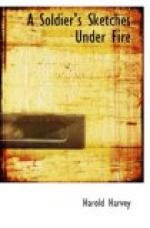CHAPTER XII.
The barred road to Calais.
Almost on the last page of my Sketch Book I come on the last sketch I took “under fire.”
“Golgotha.”
It shows the most advanced positions taken by the British in the course of one of the biggest battles of the war—at St. Julien. The trench, which was a very rough one, was originally dug by the Germans and captured by our forces in our advance. The fighting was so intense at this spot that the casualties went far into five figures on both sides, the losses of the enemy being admittedly much higher than our own. Appropriately enough was it called “Golgotha.”
[Illustration: “Golgotha.”]
To the left of the picture will be seen the remains of a building which was all that was left of what once was a magnificent chateau. The avenue of trees outlined the road to this chateau. Several trees, it will be noticed, had been either cut in two or broken off by the enemy’s shelling; by-and-by there was not one left standing. On the right of the picture the ruined building was what was left of a large farm which had a moat around it. The ruined walls of the farm were found very useful cover for our men to take whilst sniping the enemy, and by the road, at a much lower level, ran the stream which fed the lake in the grounds of the chateau. The elevation of the road giving us fair protection from the enemy’s shots, we were able, by stringing a number of boards together and making rafts, to indulge in bathing; until the water became so dirty from the earth dislodged from its banks by the shells that it was repugnant for us to indulge in ablutions in it any longer—none of us having been ordered mud bath treatment by the medical officer.
* * * * *
On the third day of the second grand attempt of the Germans to break through to the road to Calais I was bowled over by shrapnel and poison gas. Gas in cylinders and gas in all manner of shells was used against us—and our regiment had no respirators then.
Before I dropped I had the satisfaction of knowing that the Royal Fusiliers, supported by the Hampshires and the Durhams, had taken five lines of the enemy’s trenches in counter-attack; and afterwards I had the satisfaction of learning in hospital that the German casualties for the day amounted to 60,000 against British casualties of 20,000. Mine was one of about 500 gas cases—perhaps more.
IN HOSPITAL.
My hospital itinerary was from the field to the dressing station at Bailleul, thence to Boulogne; from Boulogne to Rouen, and from Rouen to Southampton and Brighton.
I like to remember that the day on which I finished my little bit for the Empire—or rather the day on which it was finished for me—was an “Empire Day”: Monday, May 24th, 1915—a day on which Britons of every clime salute the symbol of their unity and the pledge of their emergence from every peril; that dear flag under which I did what I could.




